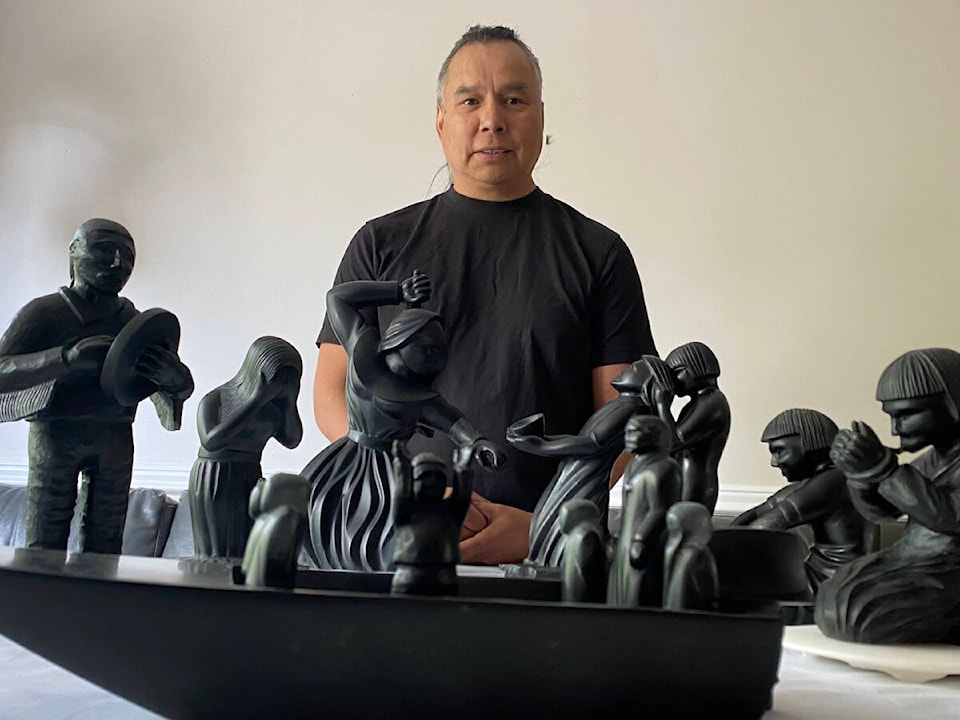Young John Sabourin waved from his front yard as the Popemobile rolled past his house in Fort Simpson on Sept. 30, 1987.
“There were 200 vehicles parked in our yard. TV cameras from all over,” Sabourin recalled. “We walked down the hill to see (Pope John Paul II) and the Dene leaders who gathered. To me it wasn’t a big deal. It was a spectacle.”
In 2022, artist John Sabourin plans to see Pope Francis for other reasons during his Canadian visit scheduled for this summer.
“I look forward to the pope coming and apologizing on behalf of the Vatican,” he said.
Sabourin has dedicated the last two years to carving out a case for a papal apology while documenting survivors’ stories in chlorite and alabaster.
When Caregivers Don’t Care: The Impact of Residential School, is a series of 10 carved figurative sculptures that express the themes of evil, horror, grief, despair and cultural survival that wind through residential school narratives.
Sabourin, who boarded for three years at the LaPointe Hall residential school in Fort Simpson, based the imagery on overlapping stories heard from loved ones and neighbours over his lifetime.
“This is a story of Indigenous culture across Canada as well as our own in the Dehcho,” he explained. “Some of it is for me. For some, I’ve heard the story. It’s a truth that has to be told and shared so it’s not forgotten. It means a lot to me.”
Sabourin’s signature carving style features meandering lines and a constant sense of fluid movement, most-often in his depiction of animals such as ravens, loons, bears or shaman in mid-transformation.
“I remember as a child always stopping to look at the snowdrifts as well as always looking up at the Northern lights. So this is what I’ve been trying to capture,” he said, referring to his style over his career.
In a departure, the present series includes figurative carvings, but they remain distinctly Sabourin.
In “Believe or you will burn in hell,” the carver uses his smooth undulating lines to depict a nun beating an unknown student. The creases and folds of her garment crawl up her tunic like fire and brimstone. In her hand she swings a rosary as a weapon, delicately carved, sanded and filed by the artist over seven days.
Sabourin produced a sculpture every four weeks or so since receiving a Canada Council for the Arts grant for the project, which had already marinated in his imagination for about a decade.
The imagery is not meant to be comfortable.
Sabourin reveals a small child peering from under a priest’s robe in “Unholy Communion” and children kidnapped by boat in “Taken from belonging.”
In “Not coming home,” a mother sobs into her palms as a child, appearing grey by Sabourin’s use of unpolished chlorite, reaches up as a memory.
A child stuffs a suitcase in “Packing for a confused and confusing home,” a large cross among her baggage.
Two girls fight over a bowl of soup in “We tear each other apart,” and a child bites on her restraints as she kneels on a disc of alabaster in the shape of a communion wafer in “Trying to be good for God.”
It’s a bleak collection, “heavy” Sabourin says, but not exclusively.
In “Healing Medicine,” a mature drummer stands firm and tall.
“He has pride in himself, his people and his culture,” Sabourin said, describing the figure.
The largest sculpture in the collection is “Hope rebirth of a family.” On one side, a woman is in labour. On the other, connected by the umbilical cord, is hope in the form of a child.
“And where there’s hope, the possibility for reconnecting is born,” said Sabourin.
Sabourin is currently working in Frozen Rock Studio in Kam Lake on a new collection of ravens, loons and bears for a show at the Adäka Cultural Festival in Whitehorse at the end of the month, followed by a visit to the Great Northern Arts Festival in Inuvik in July.
